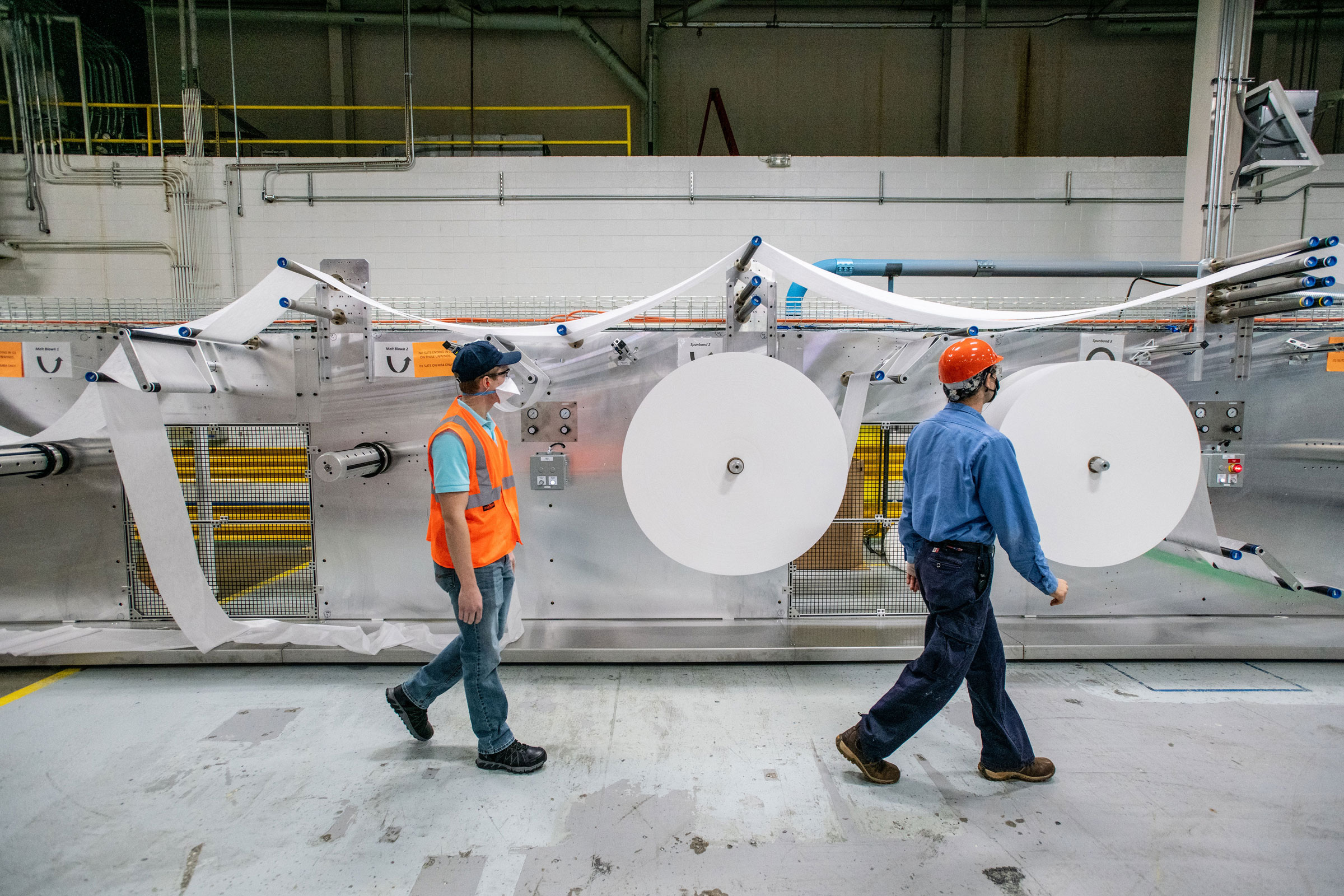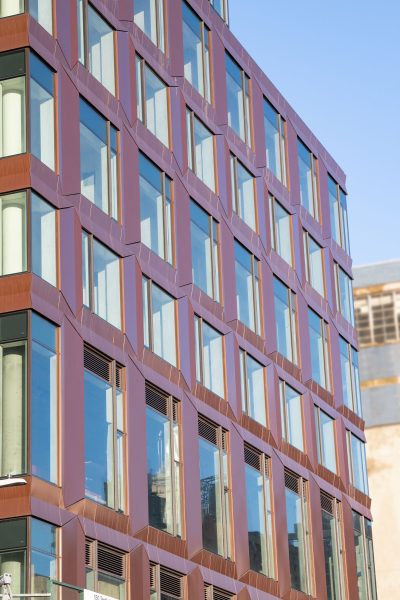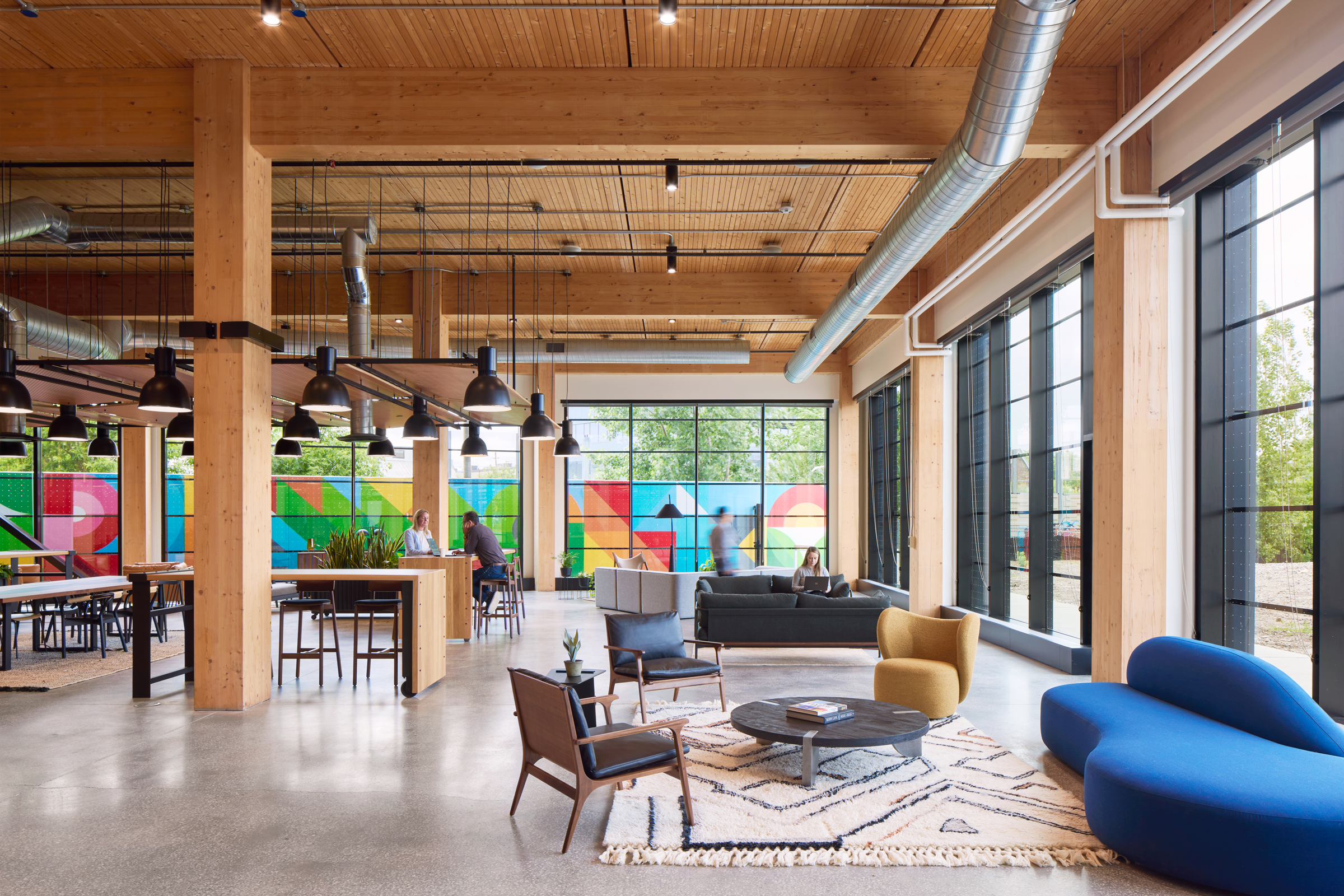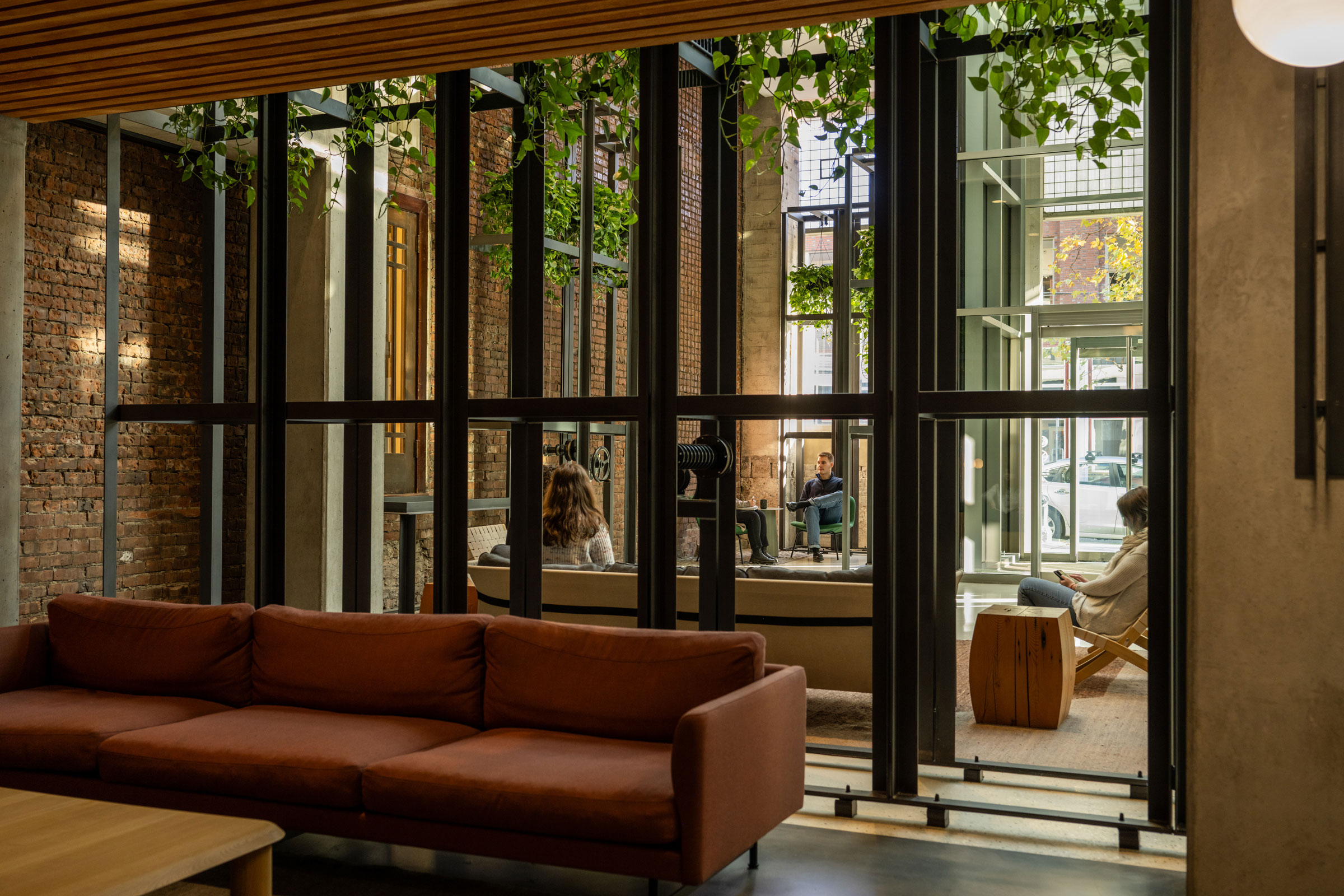Story at a glance:
- Sustainable manufacturers like Aquafil specialize in reclaiming and reusing existing materials in their products.
- Operational transparency is central to the sustainability efforts of manufacturers like Autex Acoustics, GCP Applied Technologies, and Kimberly-Clark Professional.
- Companies like Guardian Glass and Patagonia recognize that ecological conservation initiatives play an important role in sustainable manufacturing.
The manufacturing sector consumes roughly 54% of the world’s energy and is responsible for approximately one-fifth of global carbon emissions, according to the World Economic Forum. The Congressional Budget Office expects manufacturing-related emissions to increase by 17% between 2024 and 2050.
Clearly conventional manufacturing takes a toll on the environment. Fortunately many companies are working to reduce their operational emissions and overall impact on the planet.
Join us as we shine a spotlight on 10 sustainable manufacturers working to reduce their environmental and social impact.
What Makes a Manufacturer Sustainable?
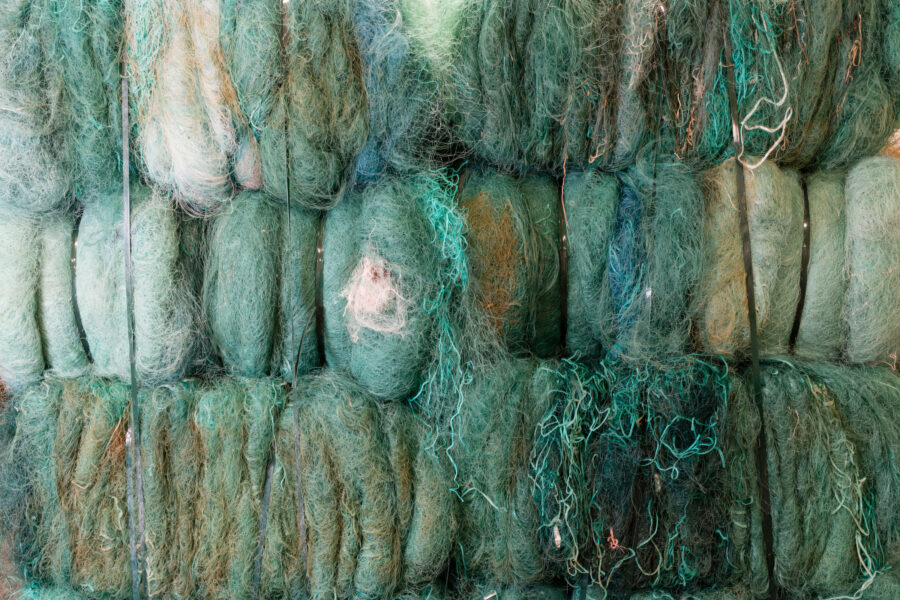
Photo courtesy of Aquafil
There are many practices, methods, and strategies manufacturers can adopt to improve their operational sustainability, particularly when it comes to environmental sustainability. Some of the most impactful include:
- Use of renewable energy
- Electrification of various manufacturing processes
- Integration of carbon capture, storage, and utilization technologies
- Ethical and responsible material sourcing
- Prioritization of nontoxic ingredients
- Waste recycling and reuse
- Adoption of circular economic principles
- Water conservation
From a holistic standpoint, truly sustainable manufacturing goes beyond environmental sustainability to include both social and economic sustainability as well. Here, sustainability might look like paying a living wage, ensuring fair treatment of workers along the supply chain, and supporting initiatives that help vulnerable communities.
Why Does Transparency Matter?
Another indicator of sustainability in manufacturing is transparency. In an age where “sustainability” has become something of a buzzword and greenwashing is more prevalent than ever, it’s not enough for companies to simply claim they are working to reduce their operational emissions and overall environmental impact; they have to provide proof as well.
This is where transparency comes into play—specifically transparency regarding emissions, materials, and procurement practices. Transparency around these topics matters because it allows consumers to make educated decisions with their money and support companies whose business practices align with their values.
Emissions transparency initiatives are among the most common of the three, with many countries—including the US—requiring manufacturers to report, at the very least, their Scope 1 and 2 emissions. Material and sourcing transparency is a bit of a different story, as extensive reporting in these categories is largely voluntary, although things like Environmental Product Declarations (EPDs), Health Product Declarations (HPDs), Declare Labels, and the like are becoming more popular.
10 Sustainable Manufacturers
Now that we have a better idea of the strategies companies use to reduce their environmental impact, let’s take a look at 10 sustainable manufacturers.
1. Autex Acoustics
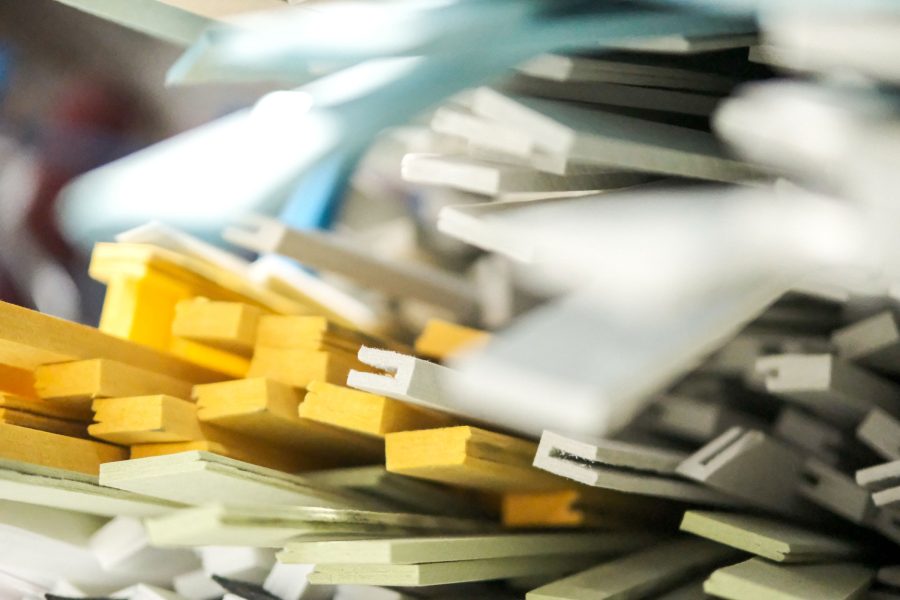
Autex Acoustics innovates and tests sustainable products and processes to push the industry forward. Photo courtesy of Autex Acoustics
As one of the world’s leading manufacturers of sustainable acoustic solutions, Autex Acoustics knows how important transparency is to maintaining a successful business. The company’s sustainability journey began in 1990 with the establishment of a zero-waste production line and has since evolved to encompass a range of environmentally-conscious methodologies—EPDs being one of them.
Autex first began publishing its EPDs in 2017—the same year they started measuring their greenhouse gas emissions—though they’ve been commissioning life cycle assessments (LCAs) for more than 20 years. “This was before there was a huge push in the industry, much less the acoustics industry, to be looking at these figures and be mindful of the way we operate and how we make our own products,” Antonio Holguin, business development and sustainability lead for Autex Acoustics North America, told gb&d in a previous article.
Autex’s Vicinity series of acoustic desk screens, for example, possesses an EPD created and verified in accordance with ISO 15804. The screens are made from 100% polyester fiber and contain at least 50% post consumer recycled content (e.g. PET plastic bottles), while also being designed for disassembly, repurposing, or recycling at the end of their operational lifespan. Vicinity products are carbon neutral, low VOC, and possess no toxicity issues of concern.
Autex has further demonstrated its commitment toward sustainablity by devising entirely new ways of recycling their products and product materials in a circular manner. The company developed the world’s first pelletizer, a machine that allows for simple and effective reprocessing of their acoustic textiles into uniform pellets that can then be manufactured into new goods. “The thought behind the project was, if this textile has come from a solid material, than a truly circular product should be able to return to a solid material,” Jonathan Mountfort, creative director at Autex Industries, previously told gb&d.
2. GCP Applied Technologies

Photo courtesy of GCP Applied Technologies
As part of the Saint-Gobain family of companies, GCP Applied Technologies—a leading provider of high-performance specialty construction chemicals and building materials—is no stranger to environmentally conscious manufacturing strategies.
Throughout 2019 GCP made extensive efficiency updates across their manufacturing facilities in three key areas: improving overall operations efficiency, reducing waste production, and implementing a process for tracking natural resources usage. Where GCP really shines, however, is in their development of durable, nontoxic, and low-carbon products that make construction projects themselves more efficient and less wasteful.
GCP’s MONOKOTE fireproofing solutions, for instance, have only about half of the global warming potential of competitors’ products and can last upwards of 50 years without needing to be replaced, drastically reducing embodied carbon. Research into alternative cementitious materials has also enabled GCP to reduce the amount of Portland cement in their products, reducing embodied carbon even further.
“Portland cement is typically a pretty bad actor when it comes to embodied carbon. That has been a focus for us over the past several years,” John Dalton, GCP’s fire protection technical service manager, previously told gb&d. “We’ve finally completed a series of tests with UL, and we have replaced the Portland cement with Portland Limestone Cement to allow us to significantly reduce the embodied carbon of our products.”
Transparency is also key to the company’s mission to improve sustainability. “We use LCAs and EPDs both internally and externally for product development and transparency,” Lisa Barnard, sustainability and customer engagement program manager for CHRYSO & GCP, told gb&d in a previous interview. “In the journey toward carbon neutrality it is important to provide accurate and robust data. To that end we work with third-party providers to assist our customers in the development of their own LCA and ultimately mix specific concrete EPDs using our admixture specific data.”
3. Aquafil
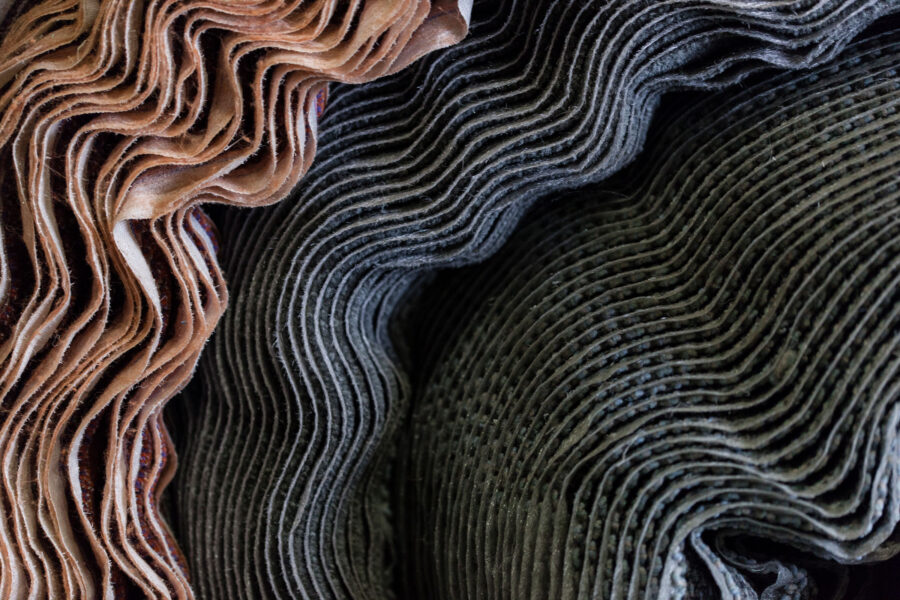
Nylon 6 waste for regeneration into ECONYL nylon. Photo courtesy of Aquafil
A leading manufacturer of synthetic yarn and fibers, Aquafil has demonstrated an unwavering commitment towards sustainability since the company first began recovering wastewater in 1990—and they don’t plan on stopping anytime soon. “In the last year alone [2024] we have spent €10.7 million on R&D activities to develop cutting-edge technologies and circular materials that reduce the industry’s negative impact on the planet,” Bonazzi, told gb&d in a previous publication. “Our objective for 2025 is to generate 60% of our fibers revenues from ECONYL nylon and other regenerated fibers. We aim to do this by increasing waste recovery, strengthening take-back programs, and educating and communicating our vision to clients.”
The company is constantly experimenting with new strategies and emerging technologies to help reduce their environmental footprint even further, with their ECONYL line of regenerated nylon being a perfect example. Introduced in 2011, ECONYL yarn is made from 100% plastic waste, at least 50% of which is consumer certified; for every 10,000 tons of recycled raw materials used, Aquafil saves 70,000 barrels of crude oil.
A large percentage of the plastic waste used to manufacture ECONYL comes from old fishing nets recovered as part of The Healthy Seas Foundation, an initiative founded by Aquafil and two other companies in 2013 that aims to collect and recycle solid waste from the world’s oceans. In 2018, Aquafil expanded their recycling capabilities even further with the inauguration of their first USA Aquafil Carpet Recycling plant, which recovers old carpets and rugs to be reused in various industries.
All plastic waste collected by Aquafil is processed via chemical recycling rather than mechanical recycling, meaning it can be recycled time and time again without experiencing a loss in quality or performance.
“ECONYL is not only a 100% regenerable product, but it’s also a product of first choice quality. It’s made to last,” Gaëlle Merlin, design and development manager at Aquafil, previously told gb&d.
Aquafil also recently announced their Born Regenerated to be Regenerable (Born R2R) project, which looks to engage manufacturers within the carpet industry to co-design circular carpets made from ECONYL that can be repurposed and regenerated at the end of their operational lifespans. Rugs and carpets bearing the Born R2R logo are quite literally designed to be disassembled, with those parts made from ECONYL yarn destined to be recovered and reused via the ECONYL regeneration process.
4. Interface
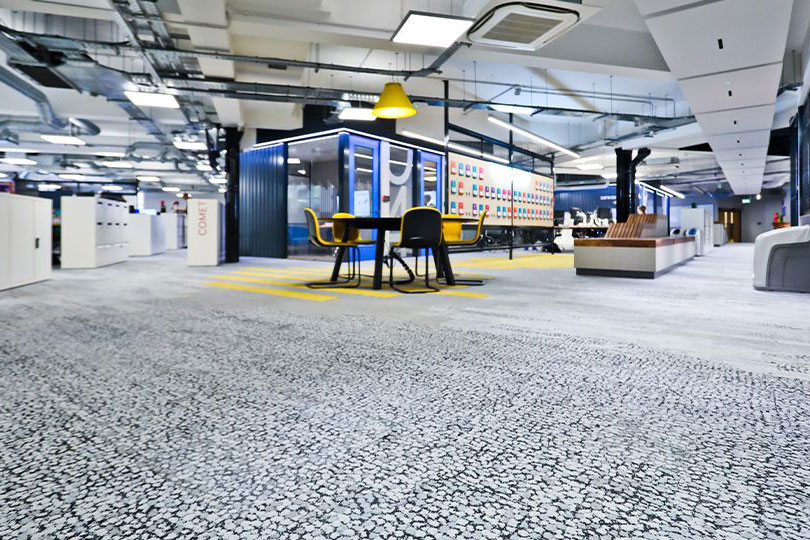
Interface redesigned Rolls-Royce’s Data Experts office. The carpet tiles are made with ECONYL® yarn. Photo courtesy of Aquafil
As the first North American flooring manufacturer to publish a third-party verified EPD, Interface is no stranger to providing their customers with product transparency. “Interface is all in on solving the climate crisis. It’s not lip service,” Erin Jende, director of marketing at Interface, previously told gb&d. “We are asking, ‘How can we most quickly move the needle?’”
Interface has published EPDs for all standard products since 2012, with 99% of all products having a product-specific EDP as of 2025. Take Interface’s newest collection of modular carpet tile, Etched & Threaded, for example. Made from Aquafil’s ECONYL and Interface’s proprietary GlasBac backing (also made using recycled content), Etched & Threaded is incredibly low-impact in terms of manufacturing, installation, and maintenance.
Interface also encourages its clients to responsibly dispose of their flooring at the end of its operational lifespan; all of its modular carpet tile, for example, is designed to be easily repurposed or recycled through their ReEntry process, further reducing its lifelong environmental impact.
5. Guardian Glass
- Guardian Bird1st UV is a highly innovative, bird-friendly glass that helps to prevent bird collisions with buildings. Photo by Alexander Sobolev
- Guardian Bird1st Etch offers acid-etched patterns. Photo by Alexander Sobolev
As we’ve seen, many sustainable manufacturers prioritize strategies like decarbonization and waste reduction when working to reduce their environmental footprint—but truly sustainable manufacturing goes beyond simply doing less harm from a pollution standpoint. Guardian Glass, a world leader in glass innovation and production, for example, demonstrates their commitment to sustainability in part through the development of bird-friendly glass solutions that help prevent undue loss of avian life.
All of Guardians’ bird-friendly products are designed in accordance with scientific research and undergo rigorous testing to ensure a high degree of in-the-field efficacy once installed. “They have solicited not only input from biologists, but also all of these products get assigned a Material Threat Factor score through the American Bird Conservancy,” Heidi Trudell, ornithologist, bird-friendly specialist, and technical advisor with Guardian Glass, previously told gb&d. “Guardian also asks, ‘What can we learn or improve from all the other testing methodologies that are available?’”
Amongst the company’s latest innovations is Bird1st UV, a bird-friendly solution whose UV coating bears a high-contrast striped pattern that’s almost invisible to humans but is visible to birds; the alternating stripes break up the glass’ surface and mark it as something that cannot be flown through, preventing confusion in birds and helping them avoid collisions that would likely result in death.
“I hope greater awareness of human impact on the environment and climate change is driving more sustainability-focused design generally,” Dan Piselli, director of sustainability and a principal at FXCollaborative—an architectural firm that has used Guardian’s products on multiple projects—previously told gb&d. “Obviously everybody is preoccupied with operational energy and human health, or lately embodied energy, and that’s all right, but part of a comprehensive approach also includes addressing ecology issues like reducing bird collisions or promoting pollinators with landscapes that help them thrive.”
Guardian Glass cares about those other aspects of sustainability as well. The company offers a selection of Cradle to Cradle–certified products in Europe and offers regional EPDs/HPDs as testament to the value they place on transparency. To reduce manufacturing-related emissions, Guardian Glass makes extensive use of Emission Control Systems and has made numerous energy-efficient improvements to their production plants around the world. They also prioritize the use of recycled glass cullet wherever possible, practice water conservation strategies, and have begun transitioning certain plants over to renewable energy.
6. ASSA ABLOY
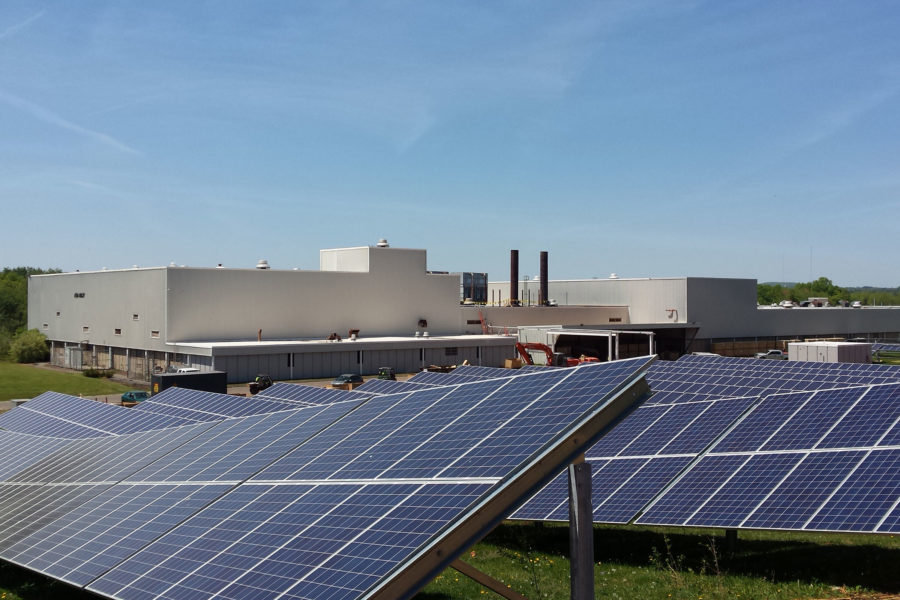
The ASSA ABLOY manufacturing facility and warehouse in Berlin, Connecticut is committed to sustainability. The solar array spans more than four acres of land. Photo courtesy of ASSA ABLOY
ASSA ABLOY is a global leader in both mechanical and digital access solutions, one that has long prioritized environmentally-friendly strategies and practices. Over the last several years, ASSA ABLOY has worked to reduce water use, improve waste management, and decarbonize their operations through a combination of energy-efficient improvements and integration of renewable energies; the company’s Berlin, Connecticut manufacturing facility, for example, generates 75% of its electricity via an on-site solar farm.
ASSA ABLOY is also working to create a more sustainable supply chain—via supplier sustainability audits and the imposition of a rigorous code of conduct for all of its business partners—to help foster ethical business practices and conserve resources.
“There are only so many resources available planet-wide,” Peter Boriskin, chief technology officer for ASSA ABLOY Americas, told gb&d in a previous publication. “The more we can be stewards of those resources—and the less of them we can take in any given product in terms of power, transportation, carbon footprint, energy, and materials—the more there is for our company and other companies going forward. It’s both good for us and for our customers and our planet.”
And like many sustainability-minded companies, material transparency is key to ASSA ABLOY’s mission. “Customers want to know what’s in the product,” Dan Picard, director of innovation at ASSA ABLOY Americas, previously told gb&d. “We pride ourselves on having the safest, most secure, and sustainable products.” All products are designed with longevity and end-recyclability in mind. We think about the whole life cycle of the product.”
Potentially harmful chemicals and compounds—like those on the International Living Future Institute’s Red List—are avoided wherever possible, with many ASSA ABLOY products carrying EPDs, HPDs, Declare Labels, GREENGUARD Gold certification. Products are also designed to help projects earn credits for green building programs like LEED and WELL.
7. Florim
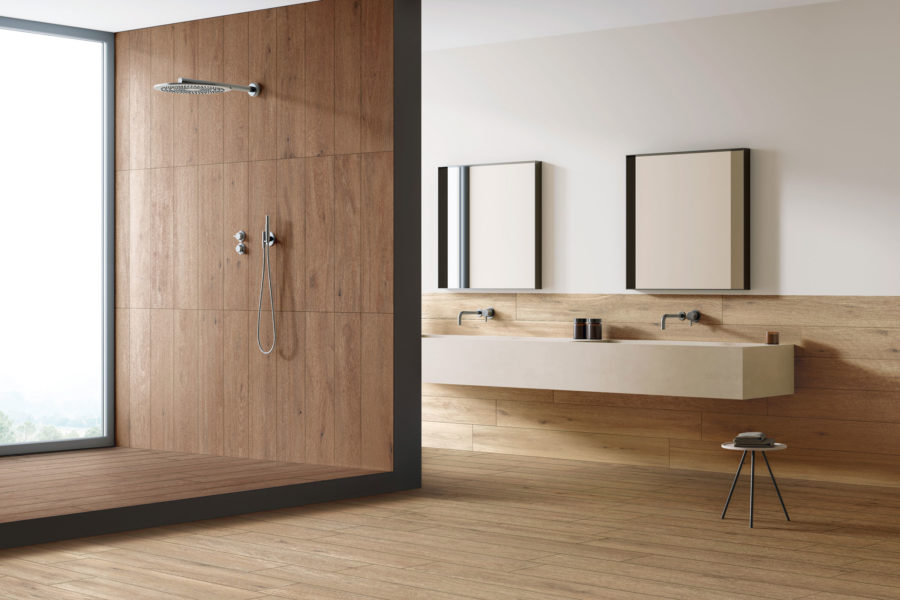
Native tile. Photo courtesy of MILE®stone
Florim—a family-owned tile and porcelain company based in Italy—is an industry leader when it comes to sustainable porcelain. Each year the company internally recycles 99.9% of its materials and all water used during production is collected and reused in other processes. “We want a clean environment to live in. We want our products to be sustainable long-term, for us now and for our children later. It’s how we look at our business and the world around us,” Don Haynes, EHS and sustainability manager for Florim USA, previously wrote for gb&dPRO.
In 2022 Florim USA—which sells its products under the MILE®stone commercial brand name—became the first porcelain tile manufacturer in the world to earn the International WELL Building Institute’s WELL Health-Safety Rating.
“The WELL Health-Safety Rating represents the company’s ongoing commitment to the well-being of our employees and customers,” Haynes said in a previous press release. “This intersects with Florim’s longstanding efforts and core values that places emphasis on health, safety, and the environment.”
All of Florim USA’s tile products are Red List–Free, GREENGUARD-certified, and made from at least 95% non-carbon containing raw materials sourced within a 500-mile radius of their Tennessee production plant.
8. Kimberly-Clark Professional
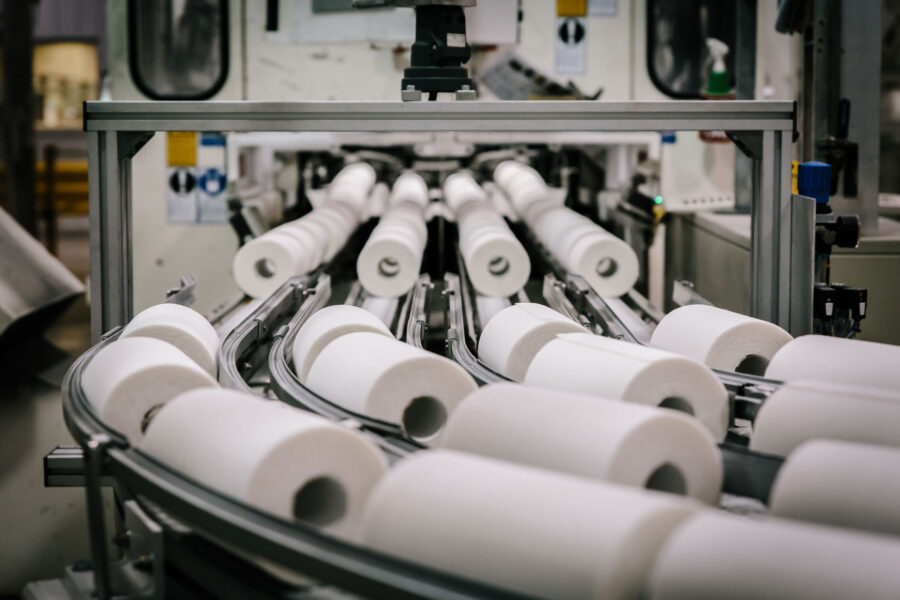
Photo courtesy of Kimberly Clark Professional
A leading manufacturer of workplace hygiene solutions, Kimberly-Clark Professional has a long history of sustainable business practices—one they don’t plan on deviating from anytime soon. The company’s 2030 Ambition plan outlines the Kimberly-Clark’s sustainability goals, of which include:
- Reducing their plastic footprint by 50% over a 2019 base year by 2030
- Reducing their Scope 1 and 2 GHG emissions by 50% over a 2015 base year by 2030
- Reducing their Natural (Northern) Forest Fiber footprint by 50% over a 2011 base year by 2025, with the ultimate goal of eliminating natural forest fibers from their products altogether
- Reducing the water footprint of company mills in water-stressed areas by 50% over a 2015 base year by 2030
- Improving the well-being of 1 billion people in vulnerable and underserved communities by 2030
“Our customers expect we will always do what’s right,” Cristine Schulz, global sustainability manager at Kimberly-Clark Professional, told gb&d in a previous publication. “Everything we share is based on data and science to reassure our customers we’re doing everything we can, in the most effective manner, to continue to innovate and reduce their carbon footprint. This helps customers meet their own sustainability goals and commitments to their employees and guests.”
Unlike some manufacturers pursuing decarbonization, Kimberly-Clark is not content with simply purchasing carbon credits to offset their emissions. Instead the company is actively working to establish partnerships and experiment with new technologies that will enable them to reduce waste and emissions at the source. A series of upgrades relating to energy efficiency made in 2019, for example, helped the company reduce their CO2 emissions by 435,000 metric tons; in 2022, Kimberly-Clark managed to achieve a 42% absolute reduction in GHG emissions, amounting to a reducing of 65,000 metric tons of CO2 from the previous year.
Kimberly-Clark has also developed several sustainability programs, including the RightCycle Recycling Program—which collects eligible PPE products for reprocessing into plastic pellets that are then used to make new consumer products—and Onvation, a smart restroom management system that can help streamline maintenance and reduce consumable waste by as much as 80%.
9. Patagonia

Patagonia’s Worn Wear includes 72 global repair centers, where more than 100,000 items were fixed in 2019. The Worn Wear team goes on the road with repair techs who fix products for free—regardless of brand—and teach customers simple ways to repair and take care of their own gear. Photo by Donnie Hedden
It’s no secret that Patagonia, the famously anti-consumerist manufacturer of outdoor apparel and gear, is a sustainability-minded company. Conservation has been a core part of the company’s ethos since its founding in 1973.
“Our mission was developed in the early ’90s after years of consideration,” Rick Ridgeway, vice president of environmental initiatives at Patagonia, told gb&d in a previous interview. “It came out of thinking that goes back to the early ’70s and the economists who first started to question the trajectory of the global economy. Part of that thinking is the importance of conserving and protecting the natural parts of the planet, which is also in Patagonia’s DNA.” Since 1985 Patagonia has pledged 1% of its sales to the restoration and preservation of the natural world and awarded $140 million dollars in cash and in-kind donations to grassroots environmental groups around the globe.
Beyond conservation efforts, Patagonia practices ethical and responsible material sourcing. Virtually all of the feather down used in Patagonia products, for example, is responsibly sourced while 100% of the virgin cotton used in their clothes is grown using regenerative, organic practices. The company also uses recycled cotton made from pre-consumer scraps and post-consumer waste in many of their products; an 82% reduction in CO2 emissions is achieved per kilogram of recycled cotton fiber compared to conventional virgin cotton.
Patagonia is also a big proponent of social sustainability, as shown by the fact that 90% of their products are made in Fair Trade Certified factories; this distinction ensures that products are manufactured under safe, fair, legal, and humane working conditions. The company also works to proactively mitigate the risk of human trafficking, forced labor, child labor, and modern slavery along their supply chain.
Something else that sets Patagonia apart from other manufacturers is its refusal to design for planned obsolescence and unwavering support of the right to repair—a sentiment best exemplified by the “if it’s broke, fix it” philosophy. Customers can, for example, easily access product care and repair guides via the company’s website or even take damaged products in for in-store repairs.
Eligible gear can also be traded in for credits that can be used in conjunction with Patagonia’s Worn Wear program. This clothing and gear reuse initiative is based on circular economic principles and gives used Patagonia products a new shot at life instead of ending up in a landfill. It’s estimated that Patagonia has sold over 120,000 repurposed items through Worn Wear since 2013.
10. Covestro
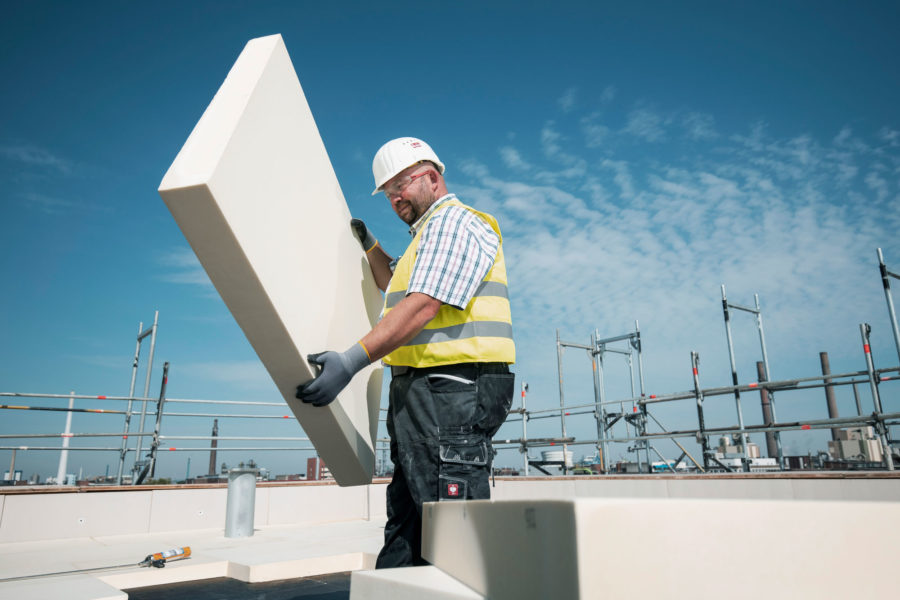
Covestro offers MDI—a core component of high efficiency rigid polyurethane insulation—in a climate neutral version through the use of bio-waste as an alternative raw material. Photo courtesy of Covestro
Covestro is one of the world’s leading manufacturers of high-quality polymer materials and is a massive proponent of the circular economy within the plastics industry. “We have forged alliances all along the value chain, from raw material suppliers to technology developers to our customers. We’ve also cleaned up our own operation, moving to more renewable energy sources. We are using research to push the boundaries into chemical recycling, which, while still in its infancy, could have massive repercussions for recycling plastics on a massive scale.”
Covestro has also taken steps to dematerialize its operations, exemplified by the company’s recent announcement regarding IMAGIO® CQ, a new digital sampling tool that replaces the need for physical sampling.
The company has also pioneered groundbreaking advancements in the use of alternative raw materials like biomass for bio-based plastics. “Covestro has been on the forefront of new research into using plant biomass to extract organic chemicals like acids, esters, alcohols, and phenols from sources including sugar cane, corn, straw, and wood,” Richard Skorpenske, head of sustainability and public affairs at Covestro, wrote in a previous gb&dPRO article.
In 2021 the company started offering a new toluene diisocyanate—a core building block in polyurethane foam—produced in part from organic wastes like used oil and grease. The following year, Covestro helped develop a breakthrough technology for producing the base chemical aniline (crucial to the production of methylene diphenyl diisocyanate, another chemical used in the creation of insulating foams) entirely from biomass. All of the carbon in this base chemical was sourced from industrial sugar, greatly reducing its GHG footprint.
What is the Future of Sustainable Manufacturing?

The future of sustainable manufacturing includes the increased integration of renewable energies and other decarbonization strategies. Image courtesy of Covestro
In 2024 the sustainable manufacturing market was valued at USD 215.4 billion—and with the emergence of new technologies and greater transparency standards, the market is projected to reach USD 367.2 billion by 2029, increasing at a CAGR of 11.3% during the forecast period.
As ESG reporting becomes more common, it is expected that more manufacturers will begin reporting data on their Scope 3 emissions as well as implement measures to reduce their Scope 3 emissions. Integration of renewable and cleaner burning energy sources is another trend that is expected to continue, as is the installation of energy-saving machinery.
As more and more cities and municipalities adopt circular economic strategies, an increasing number of manufacturers are likely to begin designing their products for ease of reuse and recyclability, with some companies potentially shifting to product-as-a-service models.
Finally, mounting calls for greater transparency within the furnishings industry have led the Sustainable Furnishings Council (SFC) to create the “What’s It Made Of?” initiative to help manufacturers find alternatives to harmful chemicals. “We have a lot of companies working with wood, upholstery foam, et cetera becoming more aware and asking what alternatives are available to them. It is frequently something they haven’t thought about. It encourages transparency in the supply chain,” Susan Inglis, executive director of the SFC, told gb&d in a previous interview. “We have a lot of companies coming to us with questions about common harmful chemicals and people are seeking alternatives. We are really excited about that.”

